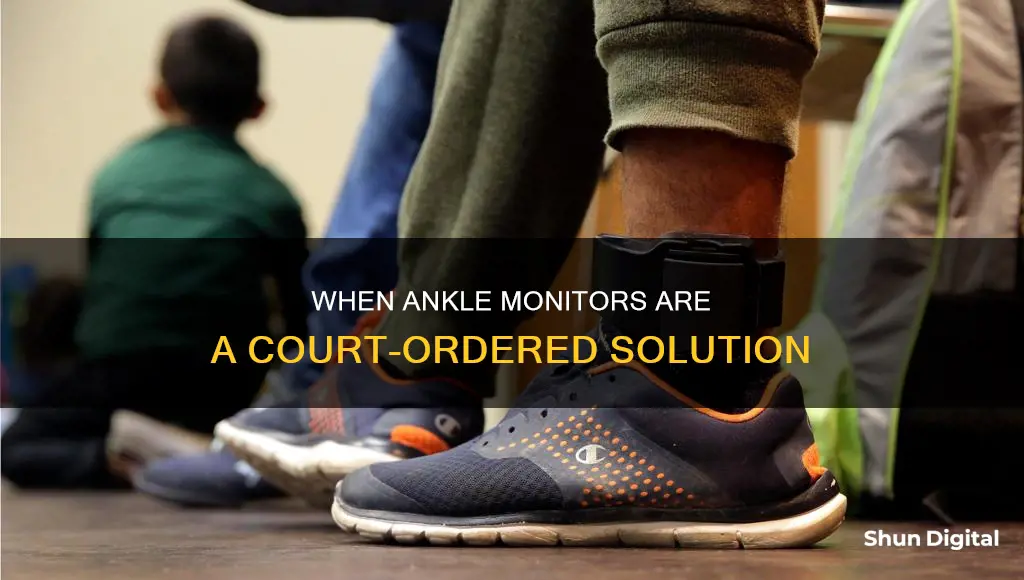
Ankle monitors are often used as an alternative to incarceration, with courts mandating their use to ensure individuals don't get into further trouble while awaiting trial or as a condition of probation. They are typically used for those considered a danger to the community or a flight risk, with the device ensuring they stay within designated boundaries. Ankle monitors are also used to track alcohol consumption for those convicted of DUI or alcohol-related offences, with the data reported to law enforcement and potentially limiting the wearer's actions and location. The use of ankle monitors has been criticised by the ACLU, who argue that they fail to meet their stated goals and instead expand mass incarceration, with monitors often leading to jail time for minor technical violations.
| Characteristics | Values |
|---|---|
| Purpose | To ensure the defendant doesn't get into more trouble, stays within boundaries set by the court, and appears for their day in court |
| Who gets them | People awaiting trial, those serving probation and parole, and those facing immigration proceedings |
| When are they used | When the defendant is a danger to the community, a flight risk, or as an alternative to a jail sentence |
| Cost | Varies, but can be up to hundreds of dollars to install and hundreds of dollars per month for monitoring services |
| Rules | Cannot be removed until the court-approved date, must be charged as instructed, cannot be damaged or removed, may have curfews or restricted travel |
What You'll Learn

To ensure the defendant appears for their day in court
Ankle monitors are often used as a way to ensure the defendant appears for their day in court. They are usually employed when an individual is deemed a flight risk or a danger to the community, allowing them to remain free while awaiting trial. The device helps ensure the defendant stays within the boundaries set by the court and adheres to any other conditions stipulated, such as avoiding certain people or adhering to a curfew.
The use of ankle monitors can vary depending on the jurisdiction, the severity of the crime, and the individual's history. They are typically used as an alternative to pre-trial detention or incarceration, providing a way to monitor the defendant's location and movements. In some cases, ankle monitors can also be used to track alcohol consumption, ensuring compliance with court orders to refrain from drinking.
The court may also mandate ankle monitors to reduce the bail amount. By agreeing to wear the device, the defendant promises to remain within a certain area, reducing the risk of them fleeing. This can result in a lower bail amount or even no bail at all.
Overall, the primary purpose of ankle monitors is to ensure the defendant's appearance in court and compliance with any set conditions, allowing for a balance between freedom and supervision.
IPS Monitor Buying Guide: Choosing the Best Display
You may want to see also

To reduce the risk of the defendant getting into more trouble
Ankle monitors are often used as a way to ensure that a defendant doesn't get into more trouble while awaiting trial or as a condition of their probation. By wearing an ankle monitor, defendants can be monitored and tracked, reducing the risk of reoffending or violating the terms of their release.
Ankle monitors are typically used for individuals who are considered a danger to the community or a flight risk. They are usually reserved for people awaiting trial and can be used as an alternative to pre-trial detention. The device helps ensure that the defendant stays within the boundaries set by the court and adheres to any other conditions, such as a curfew or avoiding certain people.
In addition to reducing the risk of the defendant getting into more trouble, ankle monitors can also be used to protect the public and ensure the defendant's appearance in court. They can also be used as an alternative to incarceration, providing a less restrictive option that allows the defendant to remain in their community while being monitored.
The use of ankle monitors can vary depending on the jurisdiction, the severity of the crime, and the individual's criminal history. They are commonly used in cases of serious crimes, such as murder, sexual assault, or major drug offenses, as well as for repeat offenders, domestic violence cases, and DUI or DWI convictions.
Overall, the main reason for requiring an ankle monitor is to reduce the risk of the defendant reoffending or violating the conditions of their release, thereby avoiding further legal trouble.
Ankle Monitor Waterproofing: Can 3M Devices Get Wet?
You may want to see also

As an alternative to a jail sentence
Ankle monitors are often used as an alternative to jail sentences. They are typically worn when a defendant is on house arrest, probation, or parole. Judges may also order ankle monitors for defendants prior to their trial.
Ankle monitors are used to track a person's location and movements, and they are monitored 24 hours a day. The device is usually strapped to the ankle and cannot be removed until the court-approved date. The monitor uses GPS technology to communicate the wearer's location to a monitoring station. Courts may rule that the wearer must stay within a specific perimeter, and if this boundary is breached, the monitor will alert the relevant authorities.
Ankle monitors are often used as a way to reduce jail overcrowding and as a more cost-effective way to manage low-risk offenders. They are also used to ensure that the wearer appears for their day in court and to reduce the risk of them getting into more trouble. For example, a person convicted of a DUI (driving under the influence) may be required to wear an ankle monitor that detects alcohol levels, ensuring they comply with court orders not to drink.
In some cases, ankle monitors can be used as a condition of probation or parole, allowing the wearer to avoid jail time. However, this form of monitoring can also lead to physical jails and prisons for minor technical violations, charging malfunctions, and false alarms. Additionally, the fees associated with wearing an ankle monitor can be burdensome, ranging from $3 to $35 per day, plus initial setup charges.
Overall, while ankle monitors can be a less restrictive alternative to incarceration, they also come with their own set of challenges and limitations.
Removing Delta Monitor Shower Handle: A Step-by-Step Guide
You may want to see also

To reduce the amount of bail needed
Ankle monitors are often used as a way to reduce the amount of bail needed. This is because they ensure the defendant will stick to the boundaries set by the court and not run away. This can increase the chance of getting a lower bail price or even no bail at all.
The bail bond service typically charges a percentage fee of the bail amount, so a lower bail amount means a lower fee. For example, if bail is set at $5,000 and the bail bond service charges a 15% fee, the defendant will incur an additional non-refundable $750 charge. However, if the defendant agrees to wear an ankle monitor, the bail amount could be reduced to $2,500, resulting in a bail bond service fee of $250.
The daily GPS fees for the ankle monitor are typically much lower than the bail bond service fee, and it can take months for the total cost to reach the amount of bail that was cut. Therefore, agreeing to wear an ankle monitor can significantly reduce the upfront cost of bail.
Additionally, ankle monitors can help to reassure the court system that the defendant does not pose a flight risk, increasing the likelihood of bail being granted. This is especially important in cases where the defendant is considered a flight risk due to being arrested in a different state than they reside in.
Furthermore, ankle monitors allow defendants to quickly return to work and continue earning an income to pay bail bond fees and GPS fees. This can help to offset the cost of bail and prevent the loss of a job.
External TV Tuners: LCD Monitor Upgrade
You may want to see also

To monitor sobriety
Ankle monitors are often used as an alternative to pre-trial detention or as a condition of probation. They can be used to monitor sobriety, particularly in cases where the defendant is a multiple DUI offender or has been convicted of an alcohol-related crime.
A Secure Continuous Remote Alcohol Monitoring (SCRAM) device is typically used to monitor sobriety. These devices are usually attached to the ankle like a bracelet and can detect and report alcohol consumption. They do this by testing the wearer's perspiration at regular intervals and measuring the concentration of alcohol through skin-level measurements. SCRAM devices are often used pre-trial to determine the defendant's alcohol consumption and in post-conviction cases to ensure the offender is adhering to the conditions of their probation.
In addition to monitoring sobriety, SCRAM devices can also track the wearer's location using GPS technology. This allows authorities to ensure the offender is complying with any geographical restrictions that have been imposed, such as maintaining a required distance from the victim in domestic violence cases.
The use of SCRAM devices can help to reduce incarceration rates and provide an opportunity for offenders to receive counselling or therapy to address their alcohol consumption. However, it is important to note that violating the terms of an ankle monitor, such as consuming alcohol or tampering with the device, can result in additional penalties, including jail time.
VA Panel Monitors: How to Identify Yours
You may want to see also
Frequently asked questions
Ankle monitors are often used as an alternative to jail time, especially for nonviolent offenders. They can be used as a condition of probation or parole, or for those awaiting trial. Ankle monitors are also used to ensure that a person isn't violating the terms of their sentence with regards to sobriety.
DUI or driving under the influence of drugs, sex offences, domestic violence, and drug crimes are some of the common crimes that can result in an ankle monitor being ordered by the court.
The rules vary depending on the individual case but some common rules include meeting with a probation or parole officer, paying court fees, abstaining from drugs and alcohol, and adhering to specific areas or curfews.







